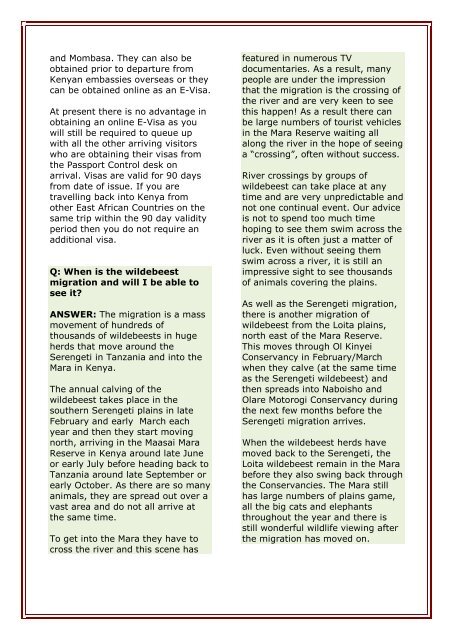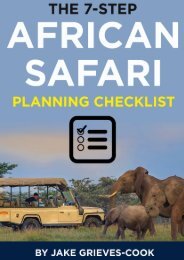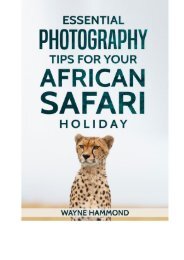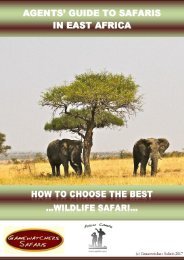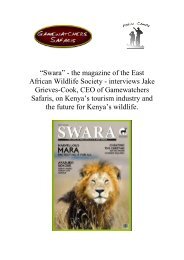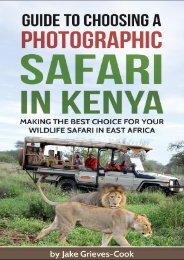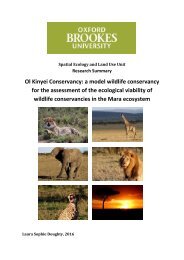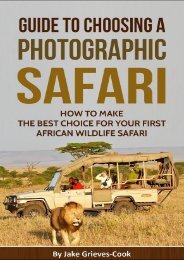How To Make The Best Choice For Your African Safari
A Guide to Choosing the Best African Wildlife Safari - where to go, what type of accommodation and transport to consider and how much it will cost.
A Guide to Choosing the Best African Wildlife Safari - where to go, what type of accommodation and transport to consider and how much it will cost.
You also want an ePaper? Increase the reach of your titles
YUMPU automatically turns print PDFs into web optimized ePapers that Google loves.
and Mombasa. <strong>The</strong>y can also be<br />
obtained prior to departure from<br />
Kenyan embassies overseas or they<br />
can be obtained online as an E-Visa.<br />
At present there is no advantage in<br />
obtaining an online E-Visa as you<br />
will still be required to queue up<br />
with all the other arriving visitors<br />
who are obtaining their visas from<br />
the Passport Control desk on<br />
arrival. Visas are valid for 90 days<br />
from date of issue. If you are<br />
travelling back into Kenya from<br />
other East <strong>African</strong> Countries on the<br />
same trip within the 90 day validity<br />
period then you do not require an<br />
additional visa.<br />
Q: When is the wildebeest<br />
migration and will I be able to<br />
see it?<br />
ANSWER: <strong>The</strong> migration is a mass<br />
movement of hundreds of<br />
thousands of wildebeests in huge<br />
herds that move around the<br />
Serengeti in Tanzania and into the<br />
Mara in Kenya.<br />
<strong>The</strong> annual calving of the<br />
wildebeest takes place in the<br />
southern Serengeti plains in late<br />
February and early March each<br />
year and then they start moving<br />
north, arriving in the Maasai Mara<br />
Reserve in Kenya around late June<br />
or early July before heading back to<br />
Tanzania around late September or<br />
early October. As there are so many<br />
animals, they are spread out over a<br />
vast area and do not all arrive at<br />
the same time.<br />
<strong>To</strong> get into the Mara they have to<br />
cross the river and this scene has<br />
featured in numerous TV<br />
documentaries. As a result, many<br />
people are under the impression<br />
that the migration is the crossing of<br />
the river and are very keen to see<br />
this happen! As a result there can<br />
be large numbers of tourist vehicles<br />
in the Mara Reserve waiting all<br />
along the river in the hope of seeing<br />
a “crossing”, often without success.<br />
River crossings by groups of<br />
wildebeest can take place at any<br />
time and are very unpredictable and<br />
not one continual event. Our advice<br />
is not to spend too much time<br />
hoping to see them swim across the<br />
river as it is often just a matter of<br />
luck. Even without seeing them<br />
swim across a river, it is still an<br />
impressive sight to see thousands<br />
of animals covering the plains.<br />
As well as the Serengeti migration,<br />
there is another migration of<br />
wildebeest from the Loita plains,<br />
north east of the Mara Reserve.<br />
This moves through Ol Kinyei<br />
Conservancy in February/March<br />
when they calve (at the same time<br />
as the Serengeti wildebeest) and<br />
then spreads into Naboisho and<br />
Olare Motorogi Conservancy during<br />
the next few months before the<br />
Serengeti migration arrives.<br />
When the wildebeest herds have<br />
moved back to the Serengeti, the<br />
Loita wildebeest remain in the Mara<br />
before they also swing back through<br />
the Conservancies. <strong>The</strong> Mara still<br />
has large numbers of plains game,<br />
all the big cats and elephants<br />
throughout the year and there is<br />
still wonderful wildlife viewing after<br />
the migration has moved on.


